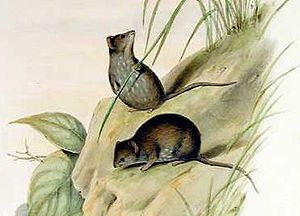Flat head pouch mice
| Flat head pouch mice | ||||||||||||
|---|---|---|---|---|---|---|---|---|---|---|---|---|

Pocket mouse ( Planigale maculata ) according to Gould |
||||||||||||
| Systematics | ||||||||||||
|
||||||||||||
| Scientific name | ||||||||||||
| Planigale | ||||||||||||
| Troughton , 1928 |
The flat head pouch mice ( Planigale ) are a genus of marsupial mammals from the family of the predator (Dasyuridae). The five species of this genus are common in Australia and New Guinea .
description
These animals are similar in appearance and behavior to the shrews , to which they are not related. As with many other pouch mice , their snout is elongated, the flattened skull is characteristic of the genus, probably an adaptation to crawling around in narrow crevices and roots. The soft fur of these animals is olive green or gray-brown in color, the evenly hairy tail is just as long as the body.
Flat-headed pouch mice are very small, and next to the Ningauis they are among the smallest marsupials. Their head body length is between 5 and 10 centimeters, their weight varies between 5 and 15 grams.
Way of life
The habitats for these animals are mainly grasslands and savannahs, and sometimes forests. Although they are primarily soil dwellers, they can climb well. They are mainly nocturnal and use crevices, tree roots or dense tufts of grass as resting places, sometimes they also build grass nests.
food
Flat-headed pouch mice are considered courageous predators who can overwhelm prey that are almost as big as they are. Insects (e.g. grasshoppers), spiders and small vertebrates such as lizards and mice are on their menu . These animals consume prey that is close to their own body weight every day.
Reproduction
The females' well-developed, back-opened pouch contains five to fifteen teats. The animals are usually fertile all year round and can have several litters per year. After a gestation period of 19 to 20 days, the female gives birth to four to twelve young animals. They spend the first few weeks of life in their mother's pouch, become independent at around three months and reach sexual maturity before their first birthday. Life expectancy is a maximum of around two years.
The species
- The common planigale ( Planigale maculata ) is one of their kind, despite their name with approximately 15 grams of weight to the larger representatives. It is common in the northern and eastern coastal regions of Australia.
- The New Guinea flat-headed pouch ( Planigale novaeguineae ) is the only species in New Guinea where it inhabits a relatively small area in the south of the island. According to the IUCN, the species is considered to be " Least Concern ".
- The northern flat head pouch mouse ( Planigale ingrami ) lives in northern Australia (from northern Western Australia to Queensland ). With a head body length of only 5 centimeters and a weight of 5 grams, it is one of the smallest marsupials. The Kimberley or dwarf flat-headed pouch mouse ( Planigale ingrami subtilissima ) mentioned in many older publications is no longer listed as a valid species / subspecies today and is considered an isolated population of the northern flat-headed pouch mouse. It has been described as even smaller at 4.6 centimeters and has not been seen since 1949 . Their occurrence was limited to the Kimberley District in Northern Australia. Until the 1980s it was also listed in Appendix I of the Washington Convention on Endangered Species (CITES).
- The southern flat head pouch ( Planigale tenuirostris ) is common in eastern and southeastern Australia. She also only reaches 5 grams of body weight.
- The Giles flat-headed pouch ( Planigale gilesi ) differs from the other species in that it has fewer teeth. She lives in the southeastern regions of Australia.
threat
The main threat to the flat-head pouch mice is stalking by introduced predators such as domestic cats or red foxes . Some species are considered rare, but this could also be due to the shy way of life. Only one species appears on the IUCN's Red List of Threatened Species , the New Guinea flat-headed pouch mouse.
literature
- Ronald M. Nowak: Walker's Mammals of the World . Johns Hopkins University Press, Baltimore 1999, ISBN 0-8018-5789-9 .